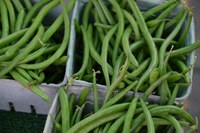Prairie Fare: Pickled Green Beans Inspire Canning Intentions
(Click the image below to view a high-resolution image that can be downloaded)
By Julie Garden-Robinson, Food and Nutrition Specialist
NDSU Extension Service
I have been admiring the beans growing in my garden and my neighbor’s garden. I planted three rows of beans, and I also have a row of pole beans climbing on a mesh framework.
One day my husband and I were admiring the neighbor’s garden, and she invited us in for some treats. No, they weren’t cookies. She pickled green beans last summer, and she shared them with us.
Before we realized it, my husband and I polished off most of a jar of green beans pickled with garlic and red pepper flakes.
“Does she know how to can safely?” he asked me later.
If he was feeling any gastrointestinal twinges, most likely it was due to the large amount of fiber we had just eaten.
“No, you will not be afflicted with botulism. She knows the safe recipes to use for canning. If she strayed from the recipe, we are in serious trouble because we ate a lot of green beans!” I added.
I’m still here to write the column, so she canned safely. I am inspired to can my own pickled beans this summer because I think I will have a bumper crop to eat fresh, freeze and can.
Many types of beans, including snap beans and dry edible beans, grow very well in the upper Midwest.
Snap beans, also commonly referred to as green beans or string beans, are close relatives to dry edible beans. They both belong to the same genus/species and together are referred to as “common beans.”
Because snap beans are picked at this young stage, the beans can be snapped in half with a simple twist of the fingers, hence the name “snap” beans. Snap bean varieties include purple, wax (yellow) and the very common green bean.
Snap beans are harvested and consumed while immature, before the inner bean in the pod has begun to develop. On the other hand, dry edible beans actually are the inner seeds of the pod and are not harvested until mature (when the pod is too firm and fibrous to be consumed fresh).
Although snap beans are botanically similar to dry edible beans, they differ greatly in nutritional value. They are an excellent, low-calorie food that contains a variety of nutrients, such as vitamins A, C and K, folate and potassium.
However, snap beans contain less starch, protein, fiber and folate than dry edible beans. While snap beans are a very nutritious food, they are not quite as nutrient-dense as dry edible beans, so they are not classified as beans or protein foods in the Dietary Guidelines for Americans. Instead, snap beans are classified as vegetables.
When selecting fresh green beans, look for beans that are deep green and straight, and snap easily. Snap beans are a delicious and versatile vegetable that can be prepared in a number of ways, including steamed, stir-fried or as part of a salad.
Canning “plain” green beans requires the use of a pressure canner because green beans are a “low-acid food.” Pickled green beans can be processed in a water-bath canner because they are canned in a vinegar brine.
See http://tinyurl.com/lowacidveggies for guidelines about canning vegetables. See http://tinyurl.com/picklinginfo for pickling information.
Here is a recipe for pickled green beans from the National Center for Home Food Preservation. Note that this recipe uses weights for the green beans. Investing in a scale and weighing the vegetables is the best way to ensure safe food preservation.
Pickled Dilled Beans
4 pounds fresh tender green or yellow beans (5 to 6 inches long)
8 to 16 heads fresh dill
8 cloves garlic (optional)
1/2 c. canning or pickling salt
4 c. white vinegar (5 percent)
4 c. water
1 tsp. hot red pepper flakes (optional)
Wash and trim ends from beans and cut to 4-inch lengths. In each sterile pint jar, place one to two dill heads and, if desired, one clove of garlic. Place whole beans upright in jars, leaving 1/2-inch head space. Trim beans to ensure proper fit if necessary. Combine salt, vinegar water and pepper flakes (if desired). Bring to a boil. Add hot solution to beans, leaving 1/2-inch head space.
Know your altitude prior to selecting your processing time. Adjust lids and process in boiling water bath for five minutes if your altitude is less than 1,000 feet, for 10 minutes if your altitude is 1,001 to 6,000 feet or 15 minutes if your altitude is above 6,000 feet. Makes about eight pints.
(Julie Garden-Robinson, Ph.D., R.D., L.R.D., is a North Dakota State University Extension Service food and nutrition specialist and professor in the Department of Health, Nutrition and Exercise Sciences.
NDSU Agriculture Communication – July 3, 2014
| Source: | Julie Garden-Robinson, (701) 231-7187, julie.garden-robinson@ndsu.edu |
|---|---|
| Editor: | Rich Mattern, (701) 231-6136, richard.mattern@ndsu.edu |


